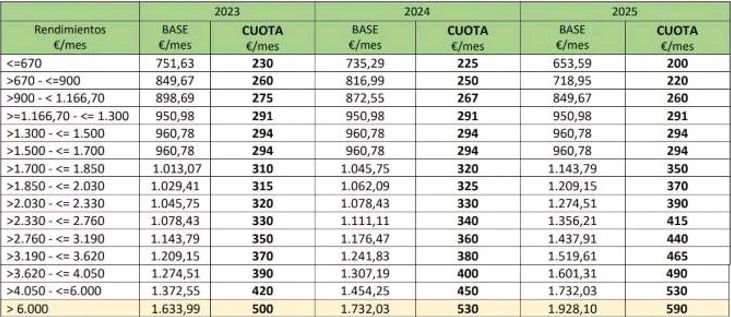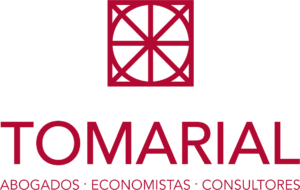After the approval of RDL 13/2022, of July 26, the contribution of the self-employed to Social Security will depend on the real income declared for tax purposes and not on a voluntarily chosen base as is the case now. The implementation of this modification will be done gradually, a maximum period of 9 years is foreseen, with periodic reviews every three years.
With the new contribution system for real income, all self-employed workers "will be obliged to present the income statement", since said information will be used to cross-check the data between the Tax Agency and Social Security, in order to verify What have the net returns of the self-employed really been?
The negotiating table has agreed on the following table for the first three years, from 2023 to 2025, in which minimum and maximum bases are attributed based on the income received, although in the table as a guide the fee to be paid has been calculated based on the minimum base of each section:

The self-employed person who, as of December 31, 2022, contributes for a higher base than it should, will be able to maintain said higher base in 2023 once the new system comes into force.
The Minister of Inclusion, Social Security and Migration has insisted that the future regime goes beyond the implementation of a contribution system based on real income, since it also aims to improve the pensions of self-employed workers.
This difference between the pensions of the self-employed and employees, of about 600 euros per month, is due to the fact that 84% of those affiliated to the Special Regime for Self-Employed Workers (RETA) contribute for the minimum base, and it affects their retirement, according to the Social Security data.
Will we find ourselves in the future with self-employed pensions lower than the current ones?
The mechanism of lowering the contribution bases for income below the minimum interprofessional salary has been used, something that directly affects both retirement pensions and short-term or permanent disability benefits.
As of January 1, 2023, the self-employed will be able to modify their contribution base up to 6 times a year instead of the current 4 times.
- March 1, if the request is made between January 1 and February 28/29
- May 1, if the request is made between March 1 and April 30
- July 1, if the request is made between May 1 and June 30
- September 1, if the request is made between July 1 and August 31
- November 1, if the request is made between September 1 and October 31
- January 1 of the following year, if the request is made between November 1 and December 31
With the contributions of the self-employed, once the year has elapsed and the regularization has been completed, they must pay the Administration; or receive a refund, for this some deadlines have been agreed in the normative text.
According to the agreed document, freelancers have one month from their notification to pay Social Security the unpaid contributions and that correspond to them based on their net income. Y the Administration has until May 31 of the fiscal year following that in which the corresponding Tax Administration has communicated the computable yields to return to the self-employed the excess quoted during that fiscal year.
The possibility of regulating a bias for the self-employed that has been postponed for so many years in the annual budgets is eliminated.
According to the aforementioned draft, the self-employed who have establishments open to the public will be able to access the benefit for cessation of activity if the requirements set out in the standard are met and even the cessation of activity due to force majeure, if applicable, according to requirements.
The flat rate will increase to 80 euros during the first 12 months of registration, although it can be extended for a further 12 months for those who earn less than the SMI in their first year of activity as a self-employed worker.
The self-employed will be entitled to a bonus for caring for a minor with cancer or another serious illness of 75% of the quota for common contingencies, which will be calculated on the average basis of the last 12 months of contributions (previously it was on the minimum basis).
The same happens with the 100% bonus of the fee for common contingencies for the care of children under twelve years of age who are in their care, for having a relative in their care, by consanguinity or affinity up to the second degree inclusive, in a situation of dependency. , duly accredited, or, for having a dependent relative, by consanguinity or affinity up to the second degree inclusive, with cerebral palsy, mental illness or intellectual disability with the degrees of disability recognized in the norm, provided that said relative does not perform a paid activity.
The quota bonuses for self-employed workers during the break due to birth, adoption, guardianship for the purpose of adoption, foster care, risk during pregnancy or risk during breastfeeding continue to be 100% of the common contingency quota but now of the minimum base of contribution of section 1 (lower than the current minimum base)
The same thing happens with the 100% discount on the quota for common contingencies for self-employed working mothers, who also takes section 1 but goes from 12 to 24 months, and the discounts on quotas in favor of certain relatives of the owner of the agricultural holding ( tranche 1) but they become 40% of the fee for common contingencies compared to the previous 30%.
This new regulation is going to require a great effort on the part of companies and advisors to keep the data of the companies up to date and the communications of the changes, updates and revisions of annual bases according to the new regulations. Will the Administration be prepared for the application of the norm when the date arrives or, as always, will we know the mechanisms for its application on the fly?
Merce Sanchez Rodriguez
Collaborator Labor Area of Tomarial


